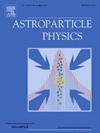Reconstruction of inclined extensive air showers using radio signals: From arrival times and amplitudes to direction and energy
IF 2.9
3区 物理与天体物理
Q1 ASTRONOMY & ASTROPHYSICS
引用次数: 0
Abstract
Radio detection is now an established technique for the study of ultra-high-energy (UHE) cosmic rays with energies above eV. The next-generation of radio experiments aims to extend this technique to the observation of UHE earth-skimming neutrinos, which requires the detection of very inclined extensive air showers (EAS). In this article we present a new reconstruction method for the arrival direction and the energy of EAS. It combines a point-source-like description of the radio wavefront with a phenomenological model: the Angular Distribution Function (ADF). The ADF describes the angular distribution of the radio signal amplitude in the 50–200 MHz frequency range, with a particular focus on the Cherenkov angle, a crucial feature of the radio amplitude pattern. The method is applicable to showers with zenith angles larger than , and in principle up to neutrino-induced showers with up-going trajectories. It is tested here on a simulated data set of EAS induced by cosmic rays. A resolution better than 4 arc-minutes () is achieved on arrival direction, as well as an intrinsic resolution of 5% on the electromagnetic energy, and around 15% on the primary energy.
利用无线电信号重建倾斜的大面积空气阵雨:从到达时间和振幅到方向和能量
无线电探测现在是一种成熟的技术,用于研究能量高于~ 1017 eV的超高能量(UHE)宇宙射线。下一代无线电实验的目标是将这项技术扩展到观测UHE掠过地球的中微子,这需要探测非常倾斜的广泛空气簇(EAS)。本文提出了一种新的EAS到达方向和能量重建方法。它将无线电波前的类点源描述与现象学模型:角分布函数(ADF)相结合。ADF描述了50-200 MHz频率范围内无线电信号幅度的角度分布,特别关注切伦科夫角,这是无线电幅度图的一个关键特征。该方法适用于天顶角大于60°的阵雨,原则上适用于具有上升轨迹的中微子引起的阵雨。它是在宇宙射线诱发的EAS模拟数据集上进行测试的。在到达方向上的分辨率优于4弧分(0.07°),电磁能量的固有分辨率为5%,一次能量的固有分辨率约为15%。
本文章由计算机程序翻译,如有差异,请以英文原文为准。
求助全文
约1分钟内获得全文
求助全文
来源期刊

Astroparticle Physics
地学天文-天文与天体物理
CiteScore
8.00
自引率
2.90%
发文量
41
审稿时长
79 days
期刊介绍:
Astroparticle Physics publishes experimental and theoretical research papers in the interacting fields of Cosmic Ray Physics, Astronomy and Astrophysics, Cosmology and Particle Physics focusing on new developments in the following areas: High-energy cosmic-ray physics and astrophysics; Particle cosmology; Particle astrophysics; Related astrophysics: supernova, AGN, cosmic abundances, dark matter etc.; Gravitational waves; High-energy, VHE and UHE gamma-ray astronomy; High- and low-energy neutrino astronomy; Instrumentation and detector developments related to the above-mentioned fields.
 求助内容:
求助内容: 应助结果提醒方式:
应助结果提醒方式:


